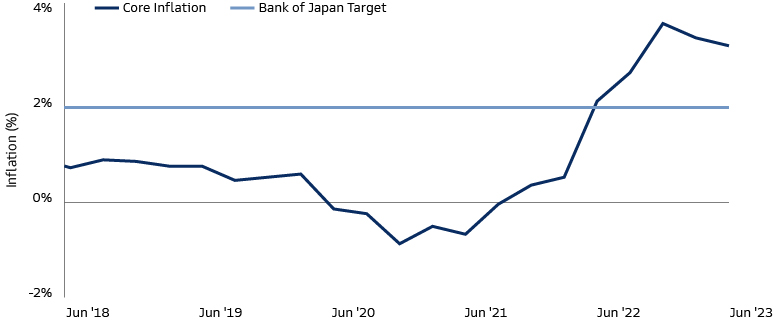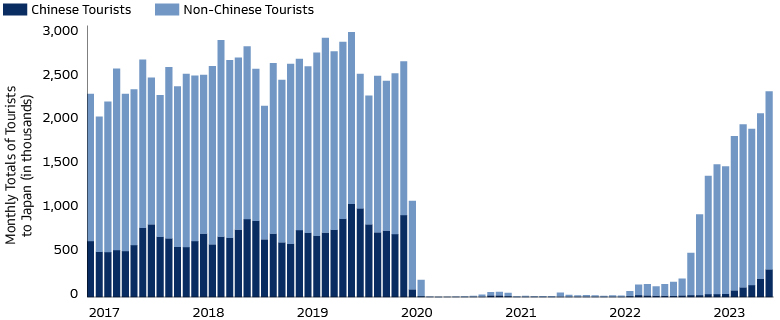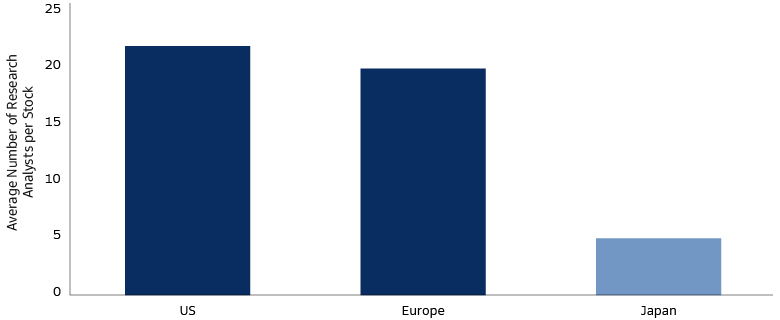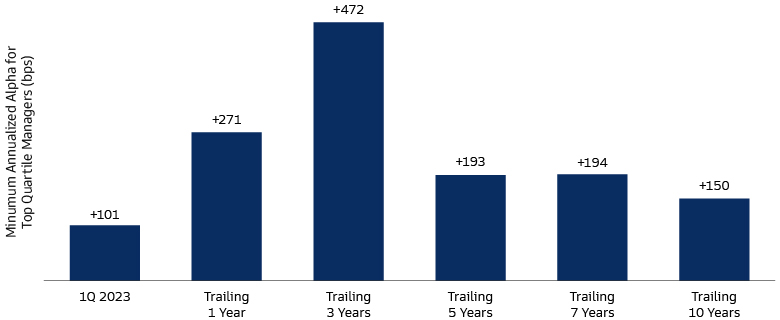Japan's Economic Revival and The Road Ahead
For three decades, Japan's economy stayed stagnant, plagued by a combination of low growth, low inflation, and low interest rates. The term “Japanification” became shorthand for the country’s prolonged economic plight and a warning to other advanced economies hoping to avoid the same fate. However, Japan’s economy is experiencing a revival in 2023, spurred by domestic macroeconomic strength, a departure from deflation, and corporate governance reform. This long-awaited resurgence and the possibility of a once-in-a-generation re-rating for Japanese assets has led to a meaningful shift in investor sentiment. The Tokyo Stock Price Index (TOPIX) hit its highest point since 1990 in mid-September and foreign investments into Japan continue to rise. The outlook for the world's third-largest economy looks more favorable than it has in many years. We believe long-term investment success in Japan requires a strategic approach; one that looks beyond near-term dynamics and considers a range of macroeconomic scenarios, domestic tailwinds, and secular trends. Active investing across public and private markets may prove rewarding if it’s combined with on-the-ground expertise and an understanding of Japanese business practices.
A New Dawn in the Land of the Rising Sun?
Rising Prices and Wage Growth
Japan finds itself in a domestic demand recovery characterized by an unfamiliar yet desirable cycle of rising prices and wage growth. Inflation is hitting levels that have not been seen since the early 1980s and has even exceeded the Bank of Japan’s (BoJ) 2% target; welcome news for an economy which has remained stagnant and faced deflation for a long time. Higher food and energy costs fueled the initial inflation ascent—consistent with global trends—but price increases have broadened out as 2023 has progressed. Services prices, for instance, have accelerated sharply, reflecting the strong increase in hotel demand amid recent re-opening momentum and the recovery in travel-related consumption. Rail fares, delivery fees and restaurant prices have all climbed higher. Simultaneously, Japan's “Shunto” negotiations between labor unions and companies have resulted in negotiated wage hikes well above usual levels. Data suggest the base pay rise (+2.12%) agreed in spring is the largest since 1992 and headline wage growth (+3.58%) is the highest since 1993.1 The extent to which this wage growth will lift inflation is a key factor for monetary policy going forward.

Source: Goldman Sachs Global Investment Research. As of June 2023.
The BoJ has long viewed a virtuous cycle between wage growth and rising prices as essential for achieving its inflation target in a sustainable manner. It remains too early to tell whether the BoJ’s desired virtuous cycle has been achieved. There has yet to be a fundamental reversal in the direction of monetary policy, which remains ultra-easy. However, we believe strength in underlying inflation—as confirmed by July and August Tokyo core CPI inflation data—supports the case for a gradual normalization of policy over the coming year, including an exit from negative interest rates. That said, we think the risk of large upward or downward swings in inflation still warrant attention. The biggest upside risk is an uncontrolled wage-price spiral, a positive feedback loop between rising wages and prices. On the other hand, extensions of government energy subsidies represent a downside risk to inflation. In August, Prime Minister Kishida announced plans to expand gasoline subsidies and extend them until the end of 2023.2 Longer term, Japan’s shrinking and aging population may have the potential to cause either inflation or deflation in the years ahead. Until now, Japan has partially offset deteriorating demographics by raising labor force participation (higher female participation and higher elderly worker participation). But in the coming decade, the impact of a shrinking workforce may exert upward pressure on wages if the labor supply doesn’t grow through immigration. Eventual outcomes may depend on Japan’s ability to enact structural reforms to improve labor force participation, as well as the interaction of demographics with other structural forces like deglobalization, decarbonization and digitization.
Yield curve control (YCC) measures continue to remain in place in Japan, having been introduced in 2016 to head off deflationary risks and to achieve an inflation target of 2%. This summer the BoJ—now under the leadership of Governor Kazuo Ueda—effectively relaxed its YCC policy by raising the rate for fixed-rate purchase operations from 0.5% to 1.0%. The rationale for the July adjustment was framed around ensuring bond market functioning, but also reflected an acknowledgement of firm inflation and rising inflation expectations. As expected, Japanese government bond (JGB) yields trended higher following the July meeting. Investors should keep potential implications for global fixed income markets in mind. Higher local bond yields may lead Japanese institutional investors to repatriate capital invested overseas back to Japan. JGB yields remain lower than fixed income assets outside of Japan. But after taking into consideration currency hedging costs—as many Japanese institutional investors do—JGB yields appear attractive in a global context. This points to a shift in asset allocation ahead and we are mindful of the impact on US agency mortgage-backed securities, US Treasuries and Australian sovereign bonds, given the large footprint of Japanese investors in these markets. That said, the speed of repatriation of capital away from global fixed income back to JGBs remains uncertain.
Investors must weigh other potential currency implications of Japan’s rising prices and wage growth, particularly in a market which has seen so little of either in the past 30 years. At present, Japanese companies with a high foreign exposure look to be in the most competitive position in decades with the yen trading at levels that have not been seen since the early 2000s. Domestic focused firms, such as consumer goods companies, retailers, and hotels, are also enjoying a long-awaited boost from increased tourism. The weaker yen makes Japan a more affordable travel destination for foreigners, notably Asian tourists. Now that yen movements have become more dramatic than in the past, foreign exchange (FX) sensitivity is an important parameter impacting corporate profitability and investment portfolios. In addition to FX hedging strategies, the key for investors may lie in finding companies with better cost structures, offshore manufacturing and market leading positions as these types of businesses tend to be resilient to exchange rate movements. Active investment managers can position themselves appropriately to ensure minimum impact from FX movements.

Source: Japan National Tourism Organization. As of July 31, 2023.
Unlocking Corporate Value
Arguably the most powerful game-changer for Japanese equities in recent years has been increased momentum of corporate governance reform. This is a key part of the “third arrow” of structural reforms first introduced when former Prime Minister Abe came into power for a second time in 2012. The Tokyo Stock Exchange (TSE) continues to focus on boosting corporate value to make Japanese stocks more compelling for investors who have long regarded Japan as a "value trap"—a market that appears attractively underpriced but fails to move toward value. One of the TSE's motivations for reform appears to be the key structural differences between the TSE Prime market and other developed stock market indices in terms of price-to-book value ratios and return on equity distributions. Japanese companies are becoming better stewards of capital and are committing excess cash to record levels of buybacks and dividends. This is attracting foreign investors back to Japan’s public equity market. The TSE is also encouraging more retail investor participation. Only 11% of Japanese household assets are invested in equities versus 20% in Europe, and almost 40% in the US.3 Going forward, further efforts to boost corporate valuations, combined with rising retail and foreign investor demand, could reinforce any upward trajectory of stock prices.
Pressure on companies that do not comply with TSE guidelines has been steadily increasing. Insufficient disclosures and explanations about areas of non-compliance, or a lack of urgency about meeting listing requirements, are now being actively highlighted as areas of concern. Companies are seeing not only pressure from the TSE, but also from investors, given increasing activist activity and investor engagement to improve management through stewardship. There is also a growing consensus about the negative implications inherent in cross-shareholdings ownership, or inter-corporate shareholding, which has been a common practice in Japan. From a capital efficiency and corporate governance standpoint, foreign investors have often emphasized that this is a key area where capital management should be improved. Taking action to avoid negative consequences can be a powerful motivator in any corporate culture, but this appears to be particularly true in the case of Japan. Data suggests more listed companies are following TSE guidelines by presenting cost of capital calculations and outlining initiatives to boost corporate value; those that did fared particularly well during 1Q 2023 earnings season.4 Looking further ahead, corporate transformation in Japan will create winners and losers, with some management teams proactively seeking to use governance reforms as a channel to achieve sustainable growth, while others fail to keep up. As active, long-term investors in Japan’s public equity market, we see the next few years as an interesting time to potentially benefit from this meaningful differentiation and continue to focus on identifying strong management teams with shareholder friendly track records.
Corporate governance reform momentum is also fueling activity in Japan’s private equity (PE) market, which has grown significantly in recent years with approximately $20 billion in deal value annually, driven by larger transactions. Dealmaking by private equity funds in Japan roughly doubled in the first six months of 2023 compared with a decline of roughly 40% in the Americas and 65% in Europe, albeit from a smaller base. Approximately half of Japan’s public equity market continues to trade at book value despite the TOPIX’s surge. As a result, take-privates and carveouts are being circled by general partners (GPs); the $14-billion take-private deal for Toshiba early this year could prove to be a harbinger.5 Japanese corporations often have a less-focused portfolio than their global counterparts, suggesting certain businesses have the potential to thrive more under independent management. The momentum behind divestitures may continue given the ongoing improvements in corporate governance and transparency.6
Capturing Long-Term Alpha
Active Exposure to Secular Growth Trends
Japan is not home to an abundance of high-growth innovators and disruptors. But it has several unique technology companies with vital roles in automation, digitization, semiconductors, electronics supply chains and advanced healthcare. Many are not well-represented by Japanese indices which continue to have significant aggregate exposure to cyclical and low growth areas such as auto manufacturers, banks, commodities, transportation, and telecom companies. These top industries make up more than 70% of the TOPIX by weight.7 Some of these sectors were prominent a few decades ago, but these are no longer the areas with the highest future growth potential. Just below this top tier in terms of size, we see many high-quality, long-term growth opportunities. This contrasts with other developed markets like the US, where the indices and markets tend to be led by the faster growing areas of the market. Japanese equities have shown one of the lowest degrees of long-term correlations with both developed and emerging market indices, driven by the uniqueness of domestic economy and corporate landscape. In our view, the key to investing in Japan will lie in identifying companies that are underrepresented within indices but that are aligned to structural growth trends, and capable of outperforming over the long-term. We believe that active managers in Japan can provide a better forward-looking exposure while limiting allocation to legacy low-growth sectors.


Source: Bloomberg. As of June 2023. eVestment. As of March 2023. Bars represent the range of returns from managers in the Japan Large Cap eVestment universe. Trailing periods as of March 2023 end. Past performance does not guarantee future results, which may vary.
Despite being home to one of the largest stock exchanges in the world, Japanese equities have largely been out of favor for many investors and under-researched, with no analysts covering 45% of the TOPIX. By comparison, only 3% of the Russell 3000 Index (a proxy for the US equity market) lacks analyst coverage. For investors with strong research capabilities, a local presence and deep understanding of accounting standards and cultural factors—including cultural conservatism, deeper and longer-term corporate business relationships—we see Japan as fertile ground for alpha generation through active management. In contrast to many other markets, the investment landscape in Japan has historically boded well for active equity managers over time with the minimum annualized alpha for top-quartile players amounting to +472 bps and +193 bps over trailing 3- and trailing 5-year periods.8 In today’s highly uncertain world, the impact of strong, consistent alpha generation is likely to be more pronounced than ever before.
Supply Chain Shifts and Geopolitics
Delivering strong and consistent returns also requires investors to identify regional and global geopolitical risks and embrace potential opportunities where they can be found. With conflicts between countries and competition for national interests becoming more pronounced, Prime Minister Kishida has committed to reinforce Japan's defense capabilities, noting cybersecurity and digitalization as increasingly important areas for national security.9 Many Japanese businesses already hold leading positions in materials and precision manufacturing, robotics, and factory automation—sectors that are likely to see strong demand as global supply chains realign and companies seek efficiency gains. The backdrop for Japan’s semiconductor industry also looks favorable with US trade restrictions on China and global semiconductor supply chains being rebuilt. Some of world’s largest semiconductor makers have announced plans to deepen tech partnerships in Japan following moves by the government to provide subsidies for domestic chipmaking. This may complement the country’s already advanced standing semiconductor packaging and substrate technologies—increasingly important areas given future technological trends like artificial intelligence (AI) rely on improved semiconductor performance. In some areas, private capital may be advantaged by its ability to provide a long-term, patient investment that reacts less to near-term geopolitical gyrations. On the other hand, public market investors with the ability to draw on both global intellectual capital and on-the-ground expertise in Japan may also be able to navigate uncertainty and generate long-term outperformance.
The Road Ahead
Japan’s economic revival and intense focus on improving governance standards have captured investors’ attention and may provide a powerful tailwind for corporate earnings in the years to come. In the near term, we expect earnings to remain resilient driven by a weaker currency, rising inbound tourism, strong corporate capex and other positive long-term structural changes that are underway. However, we expect the upcoming quarters to be key in determining whether the recent macroeconomic and market resurgence can turn into a more permanent positive reality for Japan. If both consumer and corporate activity changes in line with a shift from a deflationary to an inflationary mindset, this would likely have positive long-term implications for business, investment, and growth. Over the long-term, investment success in Japan may require an active investment approach across public and private markets. Japan seems on the cusp of a new dawn. Investors that focus on companies that are both secular growth winners and committed to corporate reforms may end up on the right side of change.
1 Goldman Sachs Global Investment Research (GIR). As of July 5, 2023.
2 The Japan Times. As of August 30, 2023.
3 Goldman Sachs Global Investment Research (GIR). As of May 29, 2023.
4 Goldman Sachs Global Investment Research (GIR). As of August 13, 2023.
5 Private Equity International. As of April 3, 2023.
6 Japan Private Equity Association. As of August 22, 2023.
7 Goldman Sachs Asset Management. Factset. As of July 31, 2023.
8 S&P Indices Versus Active (SPIVA) SPIVA Report – Japan Scorecard 2022. Past performance does not guarantee future results, which may vary.
9 Prime Minister’s Office of Japan. Policy speech at Johns Hopkins University School of Advanced International Studies. As of January 12, 2023.